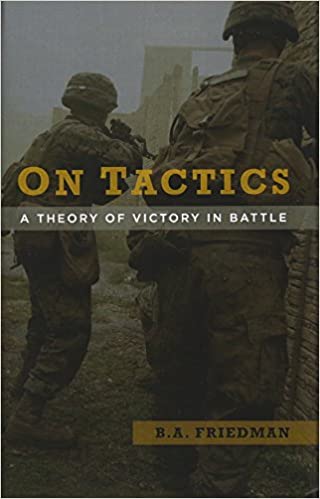‘On Tactics’ by B.A. Friedman is a fantastic book for building an understanding of tactics, and where they fit into war. I found it extremely accessible and useful for building a strong foundation of tactical understanding. Friedman sets out to build a framework for a theory of tactics. I think it’s safe to say that he succeeded with this book.
‘On Tactics’ is packed with key ideas, clear explanations, and useful examples to give the reader a short, comprehensive guide to tactics and how to think about them. It’s not a ‘how-to’ book in that it won’t tell you the winning formula for tactical victory, but it will give you a deeper understanding so you can apply the tenets in individual contexts.
‘On Tactics’ is divided into two main parts, ‘Tactical Tenets’ and ‘Tactical Concepts’. Friedman includes some useful appendices to round out the book. These include other concepts outside the scope of the main theory but still worthy of attention, such as the ‘Principles of Planning’ or the ‘Centre of Gravity’.
Friedman establishes nine tenets as principles of battle (as opposed to principles of war). The tenets are grouped across three domains (physical, mental and moral) as follows:
Physical: Manoeuvre, Mass, Firepower and Tempo
Mental: Deception, Surprise, Confusion and Shock
Moral: Moral Cohesion.
These tenets seek to address Friedman’s dissatisfaction with the existing principles of war and their confused application between the tactical and the strategic. Freidman bases the tenets on his synthesis of multiple schools of thought, from Carl von Clausewitz to J.F.C. Fuller to John Boyd. He also draws on existing doctrine and principles to develop them, which is why some may look rather familiar.
Freidman describes these tenets as guiding principles to improve the probability of achieving victory within the tactical system he crafts. This begins with defining victory as “gaining an advantage over the enemy that prevents him from accomplishing his mission.” This definition is rather broad, but rightly so. It must allow the tactician to apply the tenets creatively and avoid prescribing stagnated thoughts or out-dated solutions that lead to defeat.
To achieve this the tactician must orchestrate their forces to make best use of the physical and mental tenets in pursuit of destroying the adversary’s moral cohesion. While any combination of these tenets may produce victory, the moral dimension is the most influential and decisive on the battlefield, citing the multitude of factors that play into it, from leadership and troop welfare to belief in the cause and self-confidence. Friedman draws the importance of the moral dimension from the works of Fuller and Boyd.
The second part of the book discusses concepts that help in understanding how to apply the tenets. Friedman highlights four key concepts as follows:
- Culminating Point of Victory
- The Offense, the Defence and the Initiative
- Command and Control
- Environment and Geography.
The discussion of each concept is useful in understanding how his tactical framework should be applied. I found the discussions around the initiative in battle and mission command to be the most informative and relevant to me in my military education.
Friedman ends with a discussion on the linkage between tactics and strategy. This is arguably the most important chapter of ‘On Tactics’. Friedman describes strategy as the bridge between policy and tactics. I.e., it translates what we aim to achieve into how we can achieve it through actions. He further notes that tactics are constantly informed by and subordinated to strategy, requiring the tactician to have a degree of strategic education and acumen.
Following the main body are a series of appendices on related topics that require deeper elaboration. They provided good food for thought and helped to answer some of the questions I had from reading the main body. I particularly enjoyed the discussions on the operational art and on Friedman’s analysis of what factors make a military tactically successful.
‘On Tactics’ is extremely readable and full of useful information. Friedman does an excellent job of making what can frequently be hard to understand into clearly articulated ideas and concepts that the reader can apply. I’d highly recommend ‘On Tactics’ to junior officers, regardless of service, to aid them in understanding warfare. Friedman himself comments on the relevance of the tenets and concepts to the maritime and air domains. I have little doubt of their applicability to the cyber and space domains too. I can see this book finding a comfortable home alongside other classics of military theory, much as it has on my own bookshelf.
About the author: Chris Wooding is a Trainee Officer at the Royal Military College Duntroon. He is a Distinguished Graduate of the Australian Defence Force Academy and a Contributing Author for Grounded Curiosity. You can continue the discussion with him on Twitter @cr_wood1.

